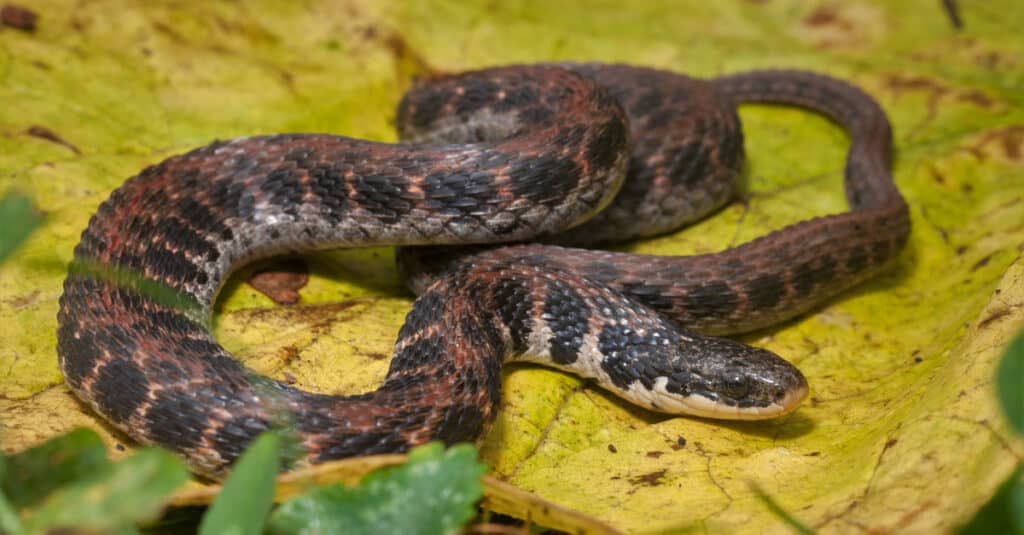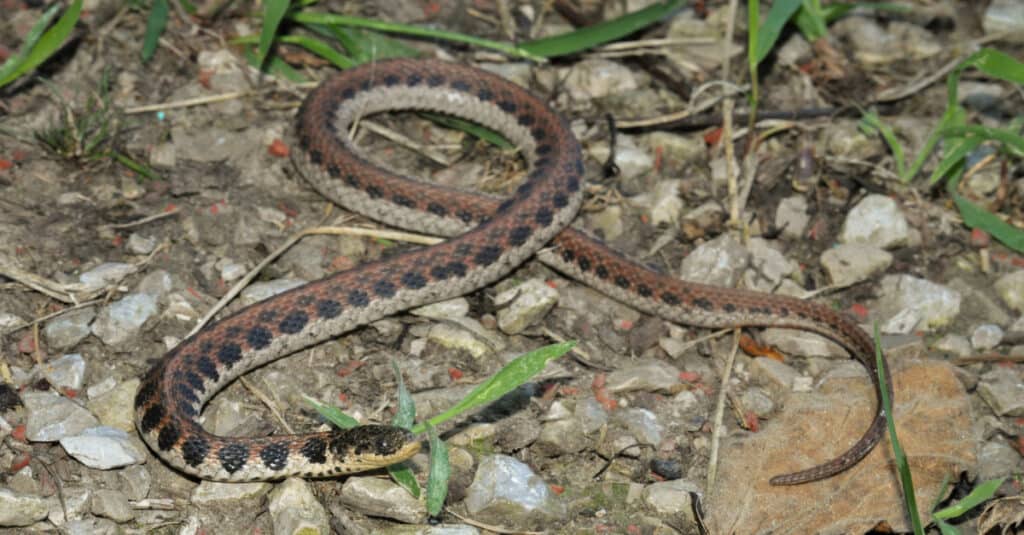In different locations of the world, Kirtland’s snakes are either threatened or endangered due to the loss of habitat from natural and human causes. They are a North American species of nonvenomous snake of the Colubridae family and the only species in the genus Clonophis.
Kirtland’s snakes are relatively small and stout-bodied. How big do they get? What is the largest Kirtland’s snake ever recorded? In this article, you’ll find answers to these questions and more.
How to Identify Kirtland’s Snake

The belly of a Kirtland’s snake is the best way to identify it: it is red, orange, or pink and has two rows of dark spots along either side.
©Mike Wilhelm/Shutterstock.com
Kirtland’s snake is a small, moderately stout snake colored reddish to grayish brown or dark brown with a series of large black, round spots on the back and alternating smaller spots running down the sides. Sometimes, a faint stripe is visible along the middle of the back. This species is easily identified by its pink, bright red, or orange belly with two parallel rows of black spots on its borders.
The snake’s head is mostly black or dark brown above with light cream-colored, white, or yellow labial scales. It also has 19 rows of keeled dorsal scales, and the anal plate is divided. However, juveniles are darker than adults, and their dorsal blotches may appear indistinct from the background.
Where Do Kirtland Snakes Live?

The natural habitat of a Kirtland’s snake includes grasslands, forests, floodplains, and open wetlands.
©Mike Wilhelm/Shutterstock.com
Kirtland’s snakes occur in Indiana, Illinois, Ohio, northern Kentucky, southern Michigan, western Pennsylvania, and northern Kentucky along the Ohio River. There’s also an isolated population of this species in the Jackson Purchase. Kirtland’s snakes are usually found in burrows or under leaf litter, rocks, logs, boards, or other cover objects within their habitats. They hibernate in burrows, especially crayfish burrows.
Even though they are less aquatic than other water snakes of the genus Nerodia within their geographic range, Kirtland’s snakes are almost always found very close to water. Their natural habitats include grasslands, forests, floodplains, and open wetlands such as wet prairies, swamps, and marshes. They are also found in open habitats in or near urban areas or large metropolitan regions such as damp vacant lots and open, grassy areas in parks.
What is the Largest Kirtland’s Snake Ever Recorded?

The largest Kirtland snakes reach a total length of about 28 inches.
©Mike Wilhelm/Shutterstock.com
Kirtland’s snakes are small and slender. An adult Kirtland snake’s average total body length (including tail) is approximately 14-28 inches. The largest Kirtland snakes reach a total length of about 28 inches (71cm).
What Do Kirtland’s Snakes Eat?
The main diet of Kirtland’s snakes includes slugs, earthworms, leeches, minnows, salamanders, toads, and frogs. They also eat birds, as well as other snakes.
What Eats Kirtland’s Snakes?
Kirtland snakes love to hide under cover, so they are less vulnerable to predation than many other snakes. Despite their reclusive behavior, they are most vulnerable to burrowing predators such as weasels, shrews, and milk snakes.
When they are above ground, they may also be preyed on by owls, hawks, foxes, skunks, raccoons, cats, and skunks. When threatened, Kirtland’s snakes are known to flatten their body and remain stiff. If they are touched, they will writhe violently and attempt to dart into cover. They may try to strike and bite, even though they are relatively small and harmless.
Are Kirtland’s Snakes Aggressive?
Kirtland’s snakes are shy animals who always try to hide or escape. They defend themselves by coiling into a position about the size of a quarter to hide from potential threats. If that fails, they flee rather than engage in any attack or fight. There’s no record of any human bitten by a Kirtland’s snake. When alarmed, the snake flattens its body extremely thin and becomes rigid. If this is not successful, it will then flee instead of fight.
How Long Do Kirtland’s Snakes Live?
The lifespan of Kirtland’s snakes in the wild is not well understood. But a common fact is that they are loved as pets by snake enthusiasts. The average lifespan of Kirtland’s snake in captivity is 8.4 years.
Are Kirtland’s Snakes Endangered?
The Kirtland’s snake is listed as endangered in Michigan, Indiana, and Pennsylvania, and it is also listed as threatened in Ohio and Illinois. However, current research on the population in Ohio is leaning towards the snake being listed as vulnerable. They are considered rare throughout their range.
Common threats to this species are habitat loss by drainage of wetlands, destruction of native prairie marshlands, and reduction of earthworm populations from the use of herbicides and pesticides. Because these snakes are sometimes found around urban centers, their populations are continually lost by development and pollution.
Kirtland’s snakes have been virtually eliminated throughout the wet prairie regions of the Midwest, which they have occupied in the past. Unfortunately, this species has lost almost all of its native habitat.
Other Record-Breaking Snakes
Fox snakes are typically between 36-54 inches in length, but they can sometimes grow up to over 60 inches. In fact, the longest fox snake on record measured an impressive 70 ½ inches long!
To put this in perspective, the largest recorded corn snake was around 74 inches long, and the biggest black racer measured approximately 6 feet, which is similar in length to the largest fox snake.
Fox snakes are found in North America, but the two species of fox snake have different habitats and don’t overlap in range. The Eastern fox snake is found in Michigan, Ohio, and Ontario, Canada, east of the Mississippi River. It prefers wetland environments such as marshes and swamps.
The photo featured at the top of this post is © Mike Wilhelm/Shutterstock.com
Discover the "Monster" Snake 5X Bigger than an Anaconda
Every day A-Z Animals sends out some of the most incredible facts in the world from our free newsletter. Want to discover the 10 most beautiful snakes in the world, a "snake island" where you're never more than 3 feet from danger, or a "monster" snake 5X larger than an anaconda? Then sign up right now and you'll start receiving our daily newsletter absolutely free.
Thank you for reading! Have some feedback for us? Contact the AZ Animals editorial team.






